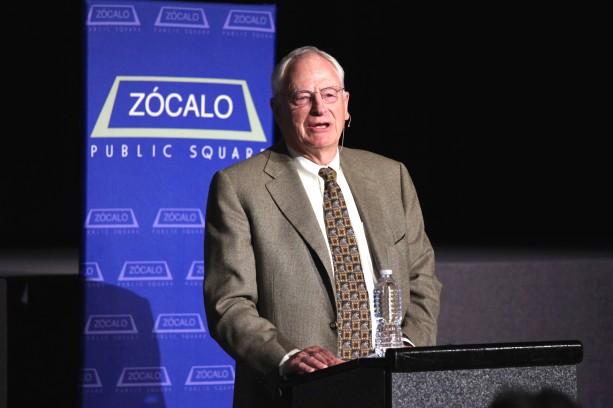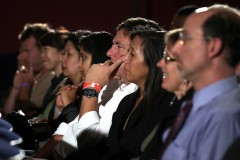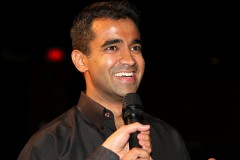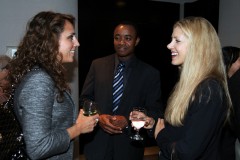
In a surprising introduction, David Lawrence, former CEO of Kaiser Foundation Health Plan and Hospitals, decided to focus on cowboys.
“The cowboy mythology suffuses many of the views about the doctor, and for the doctor, it suffuses many of our views about ourselves,” he said. Cowboys, Lawrence explained, are independent, brave, resourceful loners. Almost irascible. Think House, MD.
 The audience at the Harmony Gold Theater on Sunset Boulevard listened attentively. Lawrence soon wove together these analogies, his personal anecdotes and diverse experiences within the health care system–both managerial and political–to illuminate a trend toward medical team collaborations.
The audience at the Harmony Gold Theater on Sunset Boulevard listened attentively. Lawrence soon wove together these analogies, his personal anecdotes and diverse experiences within the health care system–both managerial and political–to illuminate a trend toward medical team collaborations.
Medical knowledge is growing at an astonishing rate. In 1950, there were about ten to twelve physician specialties, and today there are well over 120, Lawrence enumerated. (When his own 88-year-old mother fell and needed medical help, he followed her through the system for thirty days and counted at least 10 different primary physicians, 50 nurses and over 100 health care providers who tended to her needs and made decisions about her care.)
These numbers add up to a hard truth: the cowboy can’t keep up with the complexities of modern medicine. “We have models of the autonomous physician coming against modern medicine…but is the primary care physician obsolete?” Lawrence asked, before giving a resounding No.
“The patient needs a mechanism for bringing the care together,” said Lawrence. “That’s a critical role as well as trying to understand what the presenting symptoms are.”
Unfortunately, the primary-care physician is endangered, particularly when it comes to serving an aging and more diverse, non-Anglo community. Fewer and fewer medical students are choosing primary care over better-paying specialties. “It’s a situation that’s going to be aggravated over the next ten to fifteen years at least,” explained Lawrence.
The good news is that a number of new models are emerging. “My hunch is that what we’ll see over the next decade or so are variations of these models,” he said.
 One of these models is the “concierge medicine model.” That’s when wealthier subsets of the population simply pay a premium to buy direct access to primary care physicians. Lawrence doesn’t see this model as a long-term viable option, particularly because it removes primary-care doctors from an already depleted general pool.
One of these models is the “concierge medicine model.” That’s when wealthier subsets of the population simply pay a premium to buy direct access to primary care physicians. Lawrence doesn’t see this model as a long-term viable option, particularly because it removes primary-care doctors from an already depleted general pool.
The model Lawrence views as most promising involves physicians forming groups and teams. There is great evidence of success from collaborative work among primary care and secondary care physicians, particularly surrounding chronic diseases like asthma.
Still, the team model must work out a number of specifics, like how to reward a team of caretakers, rather than just one specialist, for high performance results. Payment for piece work, he said, is “antithetical to collaboration.”
Technology will also keep finding new ways to come to our aid. Codifying our health issues and simplifying the process through the use of IT shows incredible promise, said Lawrence, eliminating the need for a professional intermediary and significantly cutting back on health care costs in an unsustainable system. Technology aids triage, navigation, management, screening for preclinical disease, and wellness.
The progress of these newer models is largely determined by how much patients are willing to trust in something new. “Most of us still want our own doctor,” said Lawrence. “We still want the cowboy.”
During the question and answer section of the evening, Lawrence had the chance to opine about the health care bill.
“I supported it, I’m glad it passed, I believe it is the right move for the country. We’re paying for the people who don’t have health insurance in the dumbest way possible right now,” he said, expressing frustration at how information has been twisted. We already pay for hospital visits through our taxes, Lawrence noted, adding that constraints on insurance companies were “long overdue.” He predicted that children’s care and mental health care would show dramatic improvement under the bill.
 “If you don’t like government in health care, you probably should have gone to another country in 1965. This is not socialized medicine all of a sudden,” he quipped.
“If you don’t like government in health care, you probably should have gone to another country in 1965. This is not socialized medicine all of a sudden,” he quipped.
As far as general government involvement goes, Lawrence supports it in broad strokes but with reservations. “My biggest fear with the healthcare legislation…was that it would freeze innovation,” he said.
In any case, President Obama, said Lawrence, could have done a better job discussing the actual care part of the legislation, rather than focus on insurance companies. “I have friends that are trying to change that conversation in the White House.”
Lawrence concluded by returning to cowboys versus teamwork in medicine. In the end, he noted, even the cowboys join a corral.
See event photos here.
Watch full video here.
Read a discussion on technology and the future of medicine here.
*Photos by Aaron Salcido.




Send A Letter To the Editors